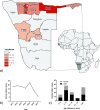Ecology and epidemiology of rabies in humans, domestic animals and wildlife in Namibia, 2011-2017
- PMID: 30990805
- PMCID: PMC6486109
- DOI: 10.1371/journal.pntd.0007355
Ecology and epidemiology of rabies in humans, domestic animals and wildlife in Namibia, 2011-2017
Abstract
Rabies is a fatal zoonotic disease that causes a heavy burden on societies. Namibia, a country in southern Africa, is aiming at controlling the disease in its main reservoir, the domestic dog. To facilitate the implementation comprehensive information on the ecology and epidemiology of the disease and surveillance is of utmost importance. The study presented assesses the baseline data for both human and animal rabies surveillance in Namibia in recent times and establishes correlations with ecological and socio-economic data in order to provide an up-to-date picture on the epidemiology of rabies in Namibia. For instance, it was important to identify the main drivers in the epidemiology, and whether the control strategy by mass vaccination of dogs is undermined by cycles of rabies in wildlife. Rabies in humans was reported mainly from the Northern Communal Areas (NCAs), with a total of 113 cases from 2011 to 2017, representing an incidence of between 1.0 and 2.4 annual human rabies deaths per 100,000 inhabitants. Kavango, the region with the highest human rabies incidence was also the region with the lowest animal rabies surveillance intensity. Generally, the vast majority (77%) of dog samples originated from communal farm land, followed by urban areas (17%), while only a small fraction (3%) was submitted from freehold farm areas. In contrast, kudu and eland submissions were almost exclusively from freehold farmland (76%) and urban areas (19%), whereas the submission of cattle samples was evenly distributed among freehold farms (46%) and communal farm land (46%). The likelihood of sample submission decreased exponentially with distance to one of the two laboratories. Overall, 67% (N = 1,907) of all samples submitted tested rabies-positive, with the highest positivity rate observed in kudus (89%) and jackals (87%). The transmission cycle of rabies in dogs appears restricted to the northern communal areas of Namibia, whilst rabies in wildlife species is predominately reported from farmland in central Namibia, mostly affecting kudu (Tragelaphus strepsiceros) and livestock with a likely reservoir in wildlife canids such as jackals or bat-eared foxes. The analysis confirms the presence of two independent transmission cycles in Namibia with little geographic overlap, thus allowing for a sustainable control of rabies in dogs in the NCAs.
Conflict of interest statement
The authors have declared that no competing interests exist.
Figures





References
-
- World Health Organization. WHO expert consultation on rabies, third report. World Health Organ Tech Rep Ser. 2018;1012:195.
-
- OIE. Chapter 2.1.17, Rabies (Infection with Rabies virus and other Lyssaviruses) OIE Manual of Diagnostic Tests and Vaccines for Terrestrial Animals. accessed 08/06/2018: http://www.oie.int/fileadmin/Home/eng/Health_standards/tahm/2.01.17_RABI...; 2018.
-
- Namibia Statistics Agency. Profile of Namibia—Facts, Fugurens, and other Fundamental Information https://cmsmyna/assets/documents/p19dpmrmdp1bqf19s2u8pisc1l4b1pdf. 2013;accessed 2018/06/09.
-
- Anonym. Human Development Report Namibia. United Nations Development Programme. accessed 06/06/2018: http://hdr.undp.org/en/countries/profiles/NAM; 2016.
Publication types
MeSH terms
LinkOut - more resources
Full Text Sources
Other Literature Sources
Medical

